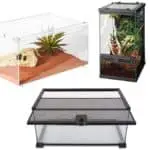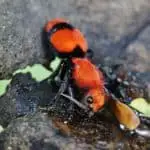Whip spiders are probably the most bizarre-looking arthropods. Despite their horrifying appearance, they actually make good pets! In this guide, I will teach you all you need to know about keeping whip spiders as pets.
To take care of a whip spider, keep it in a tall and ventilated tank decorated with cork barks. Keep it away from light and feed it with 2-3 crickets every week. Juveniles should be fed more frequently with smaller feeder insects. Make sure the enclosure is always humid.
Continue reading if you want to know more on how to care for whip spiders.
- Introduction to Whip Spiders
- Getting Whip Spiders
- Enclosure for Whip Spider
- Substrates
- Microclimates for Whip Spiders
- How to Feed a Whip Spider?
- Quenching the Thirst
- Molting
- How to Breed Whip Spiders?
- How to Care for the Whip Spider Brood
- Recommended Reading
- Recommended Supplies
- Handling Whip Spiders
- What if I Got Bitten by a Whip Spider?
- What if My Whip Spider Break Its Leg or Feeler?
- How Many Batches of Eggs will Gravid Whip Spider Lay?
Introduction to Whip Spiders
Whip spiders are also known as tailless whip scorpions and often confused as the whip scorpions. In fact, they are neither scorpions or spiders. They belong to the order Amblypygi.
Whip spiders have a flattened body. They have a pair of long pedipalps with claws which they use to catch and manipulate their prey. The first pair of legs are modified into extremely long and slender feelers (much like antennae in insects), which they use to feel and perceive their surroundings.
Whip spiders usually walk sideways like crabs, using only 3 pairs of long legs since the first pair became feelers.
Whip spiders are often found in tropical and subtropical regions. Being a nocturnal creature, whip spiders tend to hide in vertical cracks and crevices in the daytime. They only come out at night to hunt for food.
Whip spiders are not venomous. They don’t sting and they rarely bite. This makes them suitable pets for beginners.
Adult whip spiders can live for up to 20 years depending on species. Male adults and smaller species tend to live much shorter (eg. 3-10 years).
The size of whip spiders varies greatly between species. For instance, Acanthophrynus coronatus found in central and south America has a body length of 2” and leg span up to 8” while Florida’s Phrynus marginemaculatus has a body length of less than 1” and leg span up to 4”.
Note: Leg span for whip spiders is the distance measured between the tip of the 2nd pair of legs and the tip of the last pair of legs at the opposite side of the body.
Getting Whip Spiders
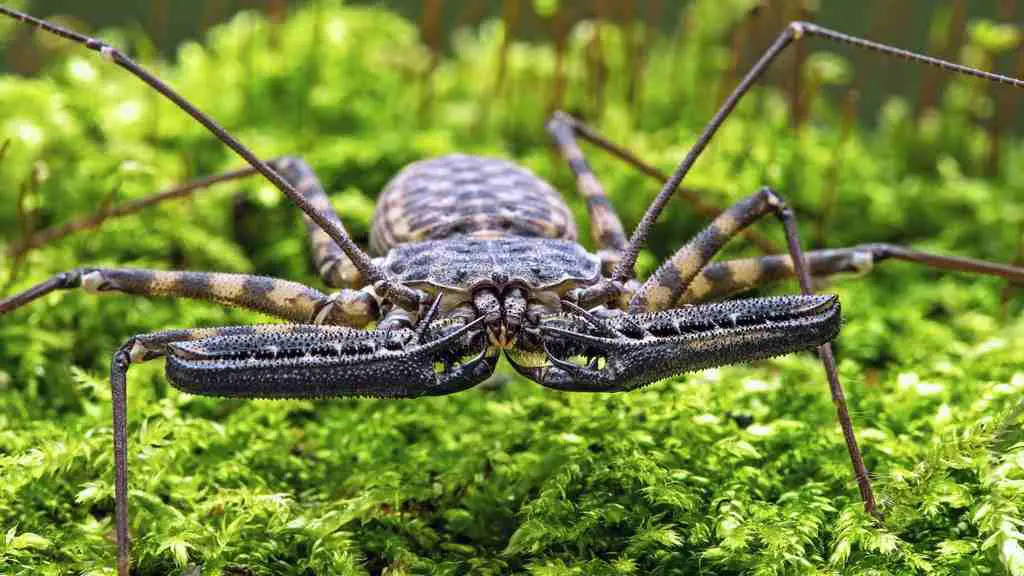
You can buy whip spiders from reputable breeders online. Just do a search on social media platforms or Google and you will be able to find something.
If you are staying in the US, you can get P. marginemaculatus. This species can be found in Florida and hence is fairly common. It is a smaller species compared to other whip spiders, with a 0.5-0.7″ body length.
Most whip spiders turn into adults within 1 to 2 years. Try to get a juvenile whip spider so that you have a clue on the age of your whip spider. It is not possible to tell the age of an adult whip spider, and you don’t want to get an aged whip spider that is dying soon.
Enclosure for Whip Spider
House your whip spider in a tall and ventilated enclosure. Decorate it with cork bark and driftwoods for the whip spider to climb and hide.
While whip spiders are small, they have very long legs. The width of your enclosure should be at least 2 times the leg span of your whip spider, and at least 3 times the leg span in height.
Because whip spiders tend to stay around vertical surfaces and hide in dark crevices, you want to decorate your enclosure in a way that provides as many vertical surfaces as possible, with some vertical or diagonal gaps in between.
Ventilation is also very important because you will need to make your enclosure humid. Although ventilation will reduce humidity, without proper ventilation you will have problems with molds.
Make sure your enclosure has a secure lid to prevent your whip spiders from escaping! You can read more about enclosure in this article.
Juveniles of some whip spider species can be housed together in the same enclosure if they are from the same brood. Examples include Florida’s P. marginemaculatus and Tanzania’s Damon diadema.
Substrates
Whip spiders don’t burrow, so substrate is not very important. But having substrates is a cheap way to keep the humidity in the enclosure high.
Add some water to coir to make it moist but not water logging. Lay the moist coir into the enclosure up to 3″ in depth. Mist the substrates weekly to keep it moist.
Microclimates for Whip Spiders
Most of the whip spiders originated from the tropical and subtropical regions. They are adapted to a warm and humid environment. Hence, you should keep them under 70-77 °F (~21-25 °C) and relative humidity at 70-80% or higher.
If the temperature is too cold, your whip spider may become inactive. Warm your whip spider by putting a heat mat on the wall of the enclosure. This will create a heat gradient for the whip spider to move to the area where it is comfortable with. A thermostat will help you to avoid overheating your whip spider.
If you keep the substrates moist and mist some water regularly, you will be able to keep the humidity high. You can also consider putting a water dish as a backup. Put some pebbles in the dish to make an escape path for feeder insects that fall in the water.
Since whip spiders are nocturnal creatures, they do not require additional lighting. You should put them away from direct light. If you want to observe them, you can use an LED display light and be sure to turn it off after you have finished watching them.
How to Feed a Whip Spider?
On a weekly basis, give your whip spider 2-3 crickets or roaches at night. Remove any leftovers on the next day to prevent growth of mold.
You might be surprised to know that the whip spiders don’t eat much, and they can’t handle prey that is too big. Keep the size of the prey half their body size. Younger individuals may need even smaller prey relative to their body size.
Whip spiders are crawling creatures. So, it is more suitable to feed them with crawling but not burrowing feeder insects such as mealworms.
I’ve written some guides on maintaining a small colony of feeder crickets or roaches that you can refer to if you want to.
If the whip spider refuses to eat, remove the feeder insects on the next day and try again after a week. The whip spiders will not eat anything when they are about to molt.
Quenching the Thirst
The whip spiders obtain most of the water they require from food. They also drink water droplets from mist. Water dish is optional if you mist regularly, but can definitely help to keep your whip spider hydrated.
Molting
The whip spiders molt in mid-air by positioning themselves upside-down underneath a solid object. They make use of their weight to help them emerge from the old skin. Hence, having enough vertical space around 2-3 times its body length is important for successful molting!
Prior to molting, your whip spider will stop feeding. It might kill the feeder insects offered but never eat them or might totally ignore them. If you see that, remove the feeder insects and leave it alone because it is extremely vulnerable during molting. Here’s a video showing how whip spiders molt to give you a better picture..
It takes a few days up a week for the newly formed exoskeleton to get hardened. The bigger your whip spider, the longer it takes. You should only continue to feed or handle your newly molted whip spider after that.
Do note that the female adults can continue to molt, unlike insects where they stop molting once they become adult. Depending on species, male may or may not molt after they turn into adults.
Lastly, keeping your whip spider hydrated and the environment humid are important to ensure successful molt!
How to Breed Whip Spiders?
Feed both whip spiders. Put the male into the tank with the female. Leave them overnight in the dark, undisturbed. Remove the male on the next day.
To breed whip spiders, you need both adult male and female of the same species. If you buy the whip spiders from a reliable breeder or seller, knowing the species is not an issue.
There is no easy way to know whether the whip spider is an adult or juvenile. But you can gauge the life stage by their age. For instance, it takes 1.5-2 years for P. marginemaculatus to turn into adults. So, if you have 2 years old P. marginemaculatus, you can try to let them mate.
Male Versus Female Whip Spiders
So, how do you know whether the whip spider is a male or female? The length of the pedipalp femur of a male whip spider is longer than the length of the femur on his second pair of legs. Females have shorter pedipalps.
Note: Femur of the arthropods is equivalent to human’s thigh.
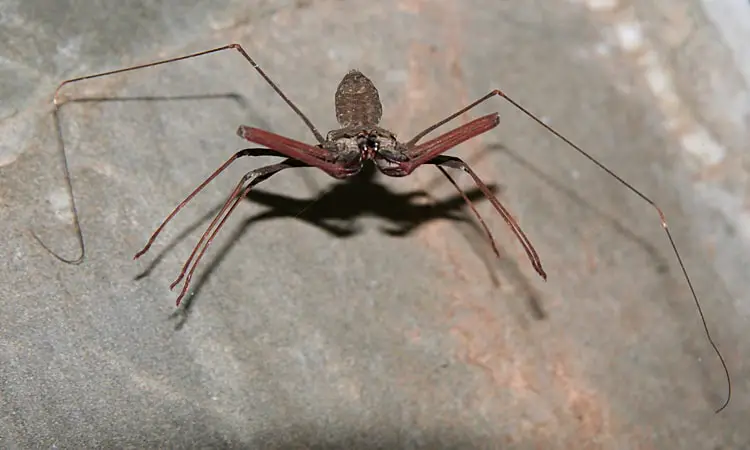
The pedipalps of the male whip spiders are long, presumably because they use them to fight other males. Longer pedipalps mean longer range attacks, which give them advantages over their competitors.
This sexual dimorphism can be observed in older individuals but not in younger juveniles. And do note that some species may not display such dimorphism.
A more accurate but difficult way to sex whip spiders is by looking at their genital opercula found underneath their body, which is essentially the opening of their genitals. The differences can be species-specific as well. I recommend you to refer to this book (affiliate link) if you want to learn more.
Whip Spiders Mating
If you house an adult male and a female whip spiders together, they will naturally mate. Be sure to dim the light and minimize air movement so that they are not disturbed and abort mating. You might also need a larger enclosure to make space for the couples and make sure they are well-fed before mating.
The mating method in whip spiders is quite similar to that of scorpions. First, the male whip spider dances to appeal to the female. He touches her with his feelers and the female responds to him. The whole process can last for 1 to 8 hours.
Once accepted, the male deposits a spermatophore containing his sperms on a surface. It looks like a long stick. He then guides the female towards the spermatophore. The female picks up the sperms from the spermatophore with her genitalia and uses the sperm to fertilize her eggs.
After that, you can remove the male from the enclosure. Some hobbyists will leave the pairs for a few days, allowing them to mate multiple times and/or to ensure mating is successful since you might not be able to confirm whether the male has produced a spermatophore and the female has picked up the sperm.
How to Care for the Whip Spider Brood
The mother whip spider takes care of her brood until their first molt. Feed the young juveniles with small feeder insects. Separate them as they grow bigger.
It may take a few weeks or months before the female lays eggs. The gravid female will lay their eggs in a sac, which she carries under her opisthosoma (ie. abdomen) for 3 to 4 months until they hatch. Depending on species, the egg sac can carry 10-60 eggs, and not all will hatch.
After the juveniles emerge from the eggs, they will be carried on the back of their mother just like what we see in scorpions.
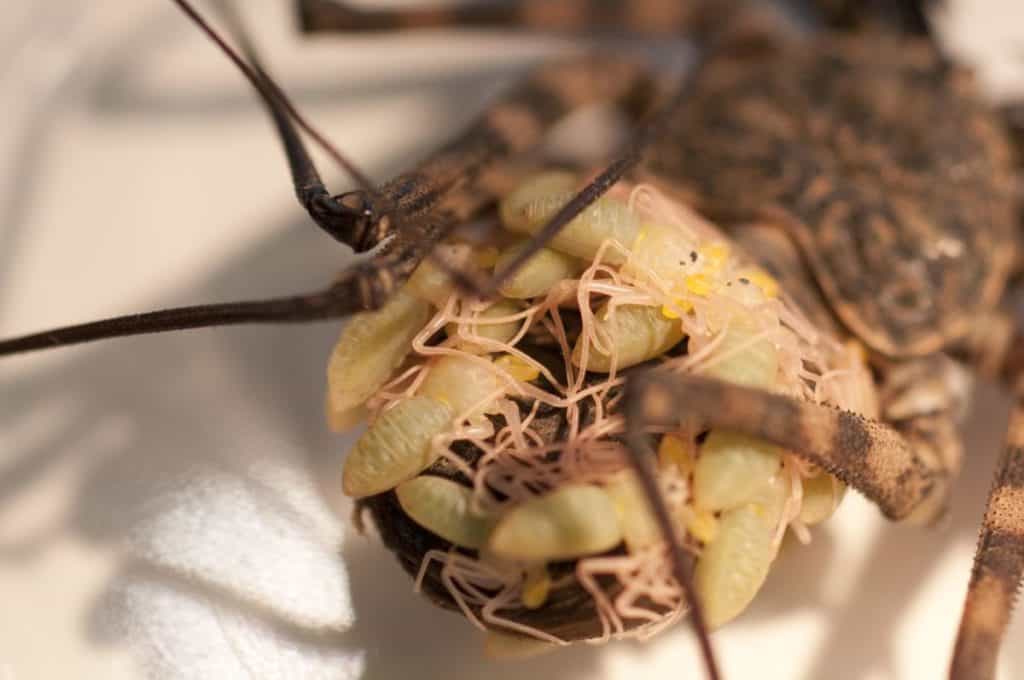
The mother whip spider remains motionless and does not eat anything while carrying her brood. You don’t have to worry about her. Just make sure you maintain the humidity in the enclosure. At this stage, the juveniles are relying on the yolks in their gut to grow.
The mother takes care of her babies for 1-2 weeks until they molt. After that, the juvenile whip spiders come down from their mothers and start hunting on their own.
Because the juveniles are still small and weak, they can’t handle stronger feeder insects. You can consider giving them flightless fruit flies or pinhead crickets. Feed them twice a week so that they grow faster.
You can keep the juveniles together in the same enclosure if you are OK to lose some of them due to cannibalism. You can reduce cannibalism by providing them enough food and hiding places.
You have to separate the juveniles into different containers after several molts. Even if you are keeping communal species, you need to separate them before they turn into adults because they will start showing aggression towards each other by then.
Recommended Reading
If you want to read more about keeping whip spiders, I recommend you to get this book by Orin McMonigle. The literature on whip spiders is very limited, and this is the only book dedicated to whip spiders. It covers all you need to know about whip spiders from a hobbyist perspective. Grab this book if you have the budget!
Recommended Supplies
Here are my recommended supplies that you can consider for keeping whip spiders. Note that I get a small commission when you buy the items through the links in this page. This helps me maintain the site without incurring additional costs to you.
- Tall glass enclosure
- Coir
- Driftwood
- Hiding cave
- Cork bark
- Tweezers
- Thermometer/Hygrometer
- Heat mat
- Lighting
- Feeder crickets
- Feeder dubia roaches
Handling Whip Spiders
Whip spiders are non-poisonous, they don’t sting, and they rarely bite. Hence, many people are not afraid of handling them. It also makes cool IG photos or shorts.
I advise you to avoid handling the whip spiders as much as possible. Not because of your safety, but for the sake of their safety. Whip spiders have very long and fragile legs and there is always a chance of hurting them during handling. You might even spontaneously crush the whip spider if it bites you. So, try not to handle it.
What if I Got Bitten by a Whip Spider?
If you get bitten by a whip spider, clean your wound with water and cover it with a band aid. The bite is not venomous but you might feel pain or itch for a few days, which should subside by itself. If you suffer from other medical complications such as increased heart beat, nausea etc., seek medical attention.
What if My Whip Spider Break Its Leg or Feeler?
Whip spiders can regain their lost limbs after the subsequent molt. The regenerated limbs are smaller, but grow larger after more molts. In fact, whip spiders may willingly drop their own leg to escape from predators.
Do note that if the breakpoint is on the femur, the whip spider can’t regenerate that limb.
How Many Batches of Eggs will Gravid Whip Spider Lay?
Whip spiders lay 1 batch of eggs per successful mating cycle. After an egg laying cycle, the female whip spider will likely molt. You will have to induce another mating session for her to lay another batch of eggs after molting.

